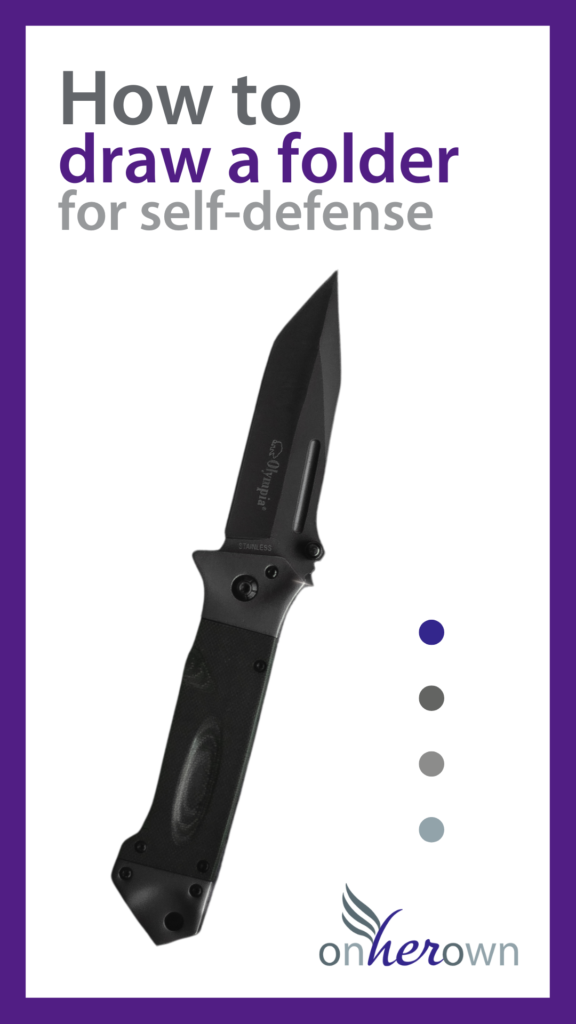
You or somebody you know probably does or has thought about carrying a knife for self-defense. There are many pros and cons to the idea generally, and I’ve talked about them before here at On Her Own. I’d like to focus today on the particular flavor of folding pocket knives. They are an incredibly popular suggestion, often carried by women as a “just in case” or last-ditch protection measure. They often look relatively innocuous, and are easy to clip onto a waistband or slip into even girl-pockets. Many are very reasonably-priced and widely available, so they’re seen as a simple safety solution.
But can they actually be effective or are they just a feel-good talisman? I’m going to put aside the legalities today, and the general considerations that you should think about when deciding to carry a self-defense tool that works only when you are within arm’s reach of your attacker and that can lethally injure them. I’m also going to put aside the overarching problem of actually being able to get to your tool at all, especially in the middle of a hands-on attack where the bad guy isn’t exactly letting you leisurely reach for whatever you want to use to defend yourself with. Instead, let’s talk about the mechanics specific to folding knives in a defensive context.
My class notes from Chris Fry‘s Progressive Folding Knife class at PFC Training begin with a simple concept: a folding knife is a broken fixed-blade knife.
That’s because the biggest challenge with folding knives is opening them and keeping them open. Some can be opened with the push of a button, the flick of a wrist, or by manipulating a stud or notch on the blade. Others require two hands to pull the blade out from the handle. While some are easy enough to unfold that they become sharp and shiny fidget toys, others require much more effort. Regardless, they are always slower and less efficient than a knife you don’t have to unfold to get into action. Even when well-practiced, the mechanisms can often be easily fouled when there is urgency and pressure to get the knife out and get it ready to use. They may even appear to unfold completely but with the locking mechanism not fully engaged so that the knife will fold at the slightest resistance against the blade. Rushing to be the first to offer a blade to open a box and having the knife fail to open correctly is one thing, but an entirely different matter altogether in a fight. It’s even harder to get a folding knife completely open when someone is physically trying to stop you from defending yourself. You don’t need to imagine wildly to think about how you might not be able to use one of your hands if you are attacked, or how you might lose the motor skills and coordination to open your knife if someone has grabbed you or started hitting you violently. For that matter, consider how regular environmental factors might make unfolding a knife difficult when you need it, like your hands being cold (or gloved) or slippery because of sweat or rain.
I really liked Chris’s STAB technique to access a folding knife clipped to your clothing in the most reliable way possible (click the image above to see it). Good gear selection will make a difference to increase your odds of success (doesn’t it always?), but the technique itself is robust even if the tool you’re using isn’t ideal. It goes like this: clear any cover garments, then SLAP where you are carrying the knife, with your fingers splayed; TUCK your thumb behind the knife so you can locate the opening mechanism; ACCESS the knife by pulling it off of where it is clipped, keeping your fingers at the end of the clip; BRACE your hand to your hip immediately in order to anchor the knife to yourself. Bracing the knife will make opening more reliable and make it harder for you to lose the knife in the fight. Opening or deploying the blade gets a bit more complicated, and while he showed us several techniques, the “push” method I show in this video was my favorite for being robust and reliable across a range of knives. Of course, the most efficient method for you is going to depend on how the knife fits you, the opening mechanism built into the knife, and the method you use best. Regardless, all of this depends on having enough time and space to access and open the blade, so keep in mind what that might involve though it’s beyond the scope of this article.
Then there’s issue of the blade staying locked open so that you can stab and cut with it. Whether a knife is easy or hard to fold back up isn’t necessarily an indicator of whether it will stay unfolded when you are hacking away at a bad guy and thrusting a blade at them trying to save yourself. The forces generated by those kinds of motions, against flesh and bone, can cause the knife to fold up over your hand or fingers. Not only might that cause severe injury to you, it can mean you don’t have anything effective to use against your attacker. Selecting a strong lock mechanism that isn’t prone to failure is extremely important, and I recommend prioritizing axis-style locks and frame locks. Liner locks and lock-backs can be acceptable, but with a number of technical caveats beyond my scope here. Suffice it to say that any folding knife you’re thinking of using defensively in any capacity must have a known lock type from a reputable manufacturer. If you can’t find out what kind of lock is used on a particular knife you’re looking for, chances are pretty good it’s not one of the stronger, better types. In addition, the knife itself should be well-maintained. It’s not enough that you keep the blade sharpened with folders, because a faulty lock is as bad as one that is inherently prone to failure. Problems as simple as pocket lint or exposure to water or common chemicals can be enough to make a opening or locking mechanism stop functioning correctly, and you might not be able to tell until it doesn’t work when you need it to.
The other danger of a sub-optimal locking mechanism is that they can make using the knife risky normally too, especially when it comes to closing them. Certain designs make it difficult or impossible to keep all of your fingers out from between the sharp edge of the blade and the handle where you are returning it. You’re supposed to disengage the locking mechanism with your fingers in the way, then move them to swing the blade back to the handle. If you aren’t being careful, you can cut yourself. The problem is exacerbated when the mechanism is not in ideal condition, perhaps too stiff because it’s new or degraded because it’s old or dirty, which can make the knife harder to close than anticipated, or the speed of closing more unpredictable. It’s not an issue that will come up in the middle of a self-defense situation, but I suggest that if you are planning on using your pocket knife for utility purposes like opening boxes, being hurt by it during daily use is as bad as or worse than being hurt by it malfunctioning during any defensive encounter. Learning and practicing proper opening and closing technique helps, as does cleaning, inspecting, and maintaining your knife regularly. If you don’t know how to perform maintenance or repair on your knife and notice that it isn’t working normally and comfortably, stop using it and contact the manufacturer or an expert. And that’s true regardless of why you own a folding knife.
Finally, remember that even if your knife opens and stays open when you want it to, and you can close it without hurting yourself, there’s also whether it will hurt you in an unintended way while you are using it. Almost all fixed-blade knifes have some sort of stop or other design feature that helps keep your hand from sliding onto the sharp, slicey part even if you are slashing or stabbing with force. Not all folding knives do, or do aggressively enough to keep your hand in place during a fight. That’s especially true if you choose to use a reverse grip, with the blade sticking out from the pinky side of your hand instead of the thumb side. Some also have slippery handle scales that may be very pretty, but don’t have enough texture to hold onto tightly. While it’s true that a bad guy is not likely to grab and hold onto the pointy end of your knife to wrest it away from you, your hand might still get wet with blood or sweat that can interfere with your grasp and you still might lose your grip if the handle is too big or small for you. Your blade might also make contact against some part of the bad guy’s body or clothing that will make it stick or catch, so that your hand keeps going after the knife has stopped, or the knife tries to tear itself out of your hand. Knives of any kind are full-contact weapons, so it’s important that they are hard to drop and that they protect you from hurting yourself with them.
It’s not that folding knives should never be used for self-defense, but that they come with a lot of complexity and require some extra knowledge and skills to be effective. They might be the perfect choice for your situation, but you should decide that after you’ve fully considered both the upsides and downsides of them.





